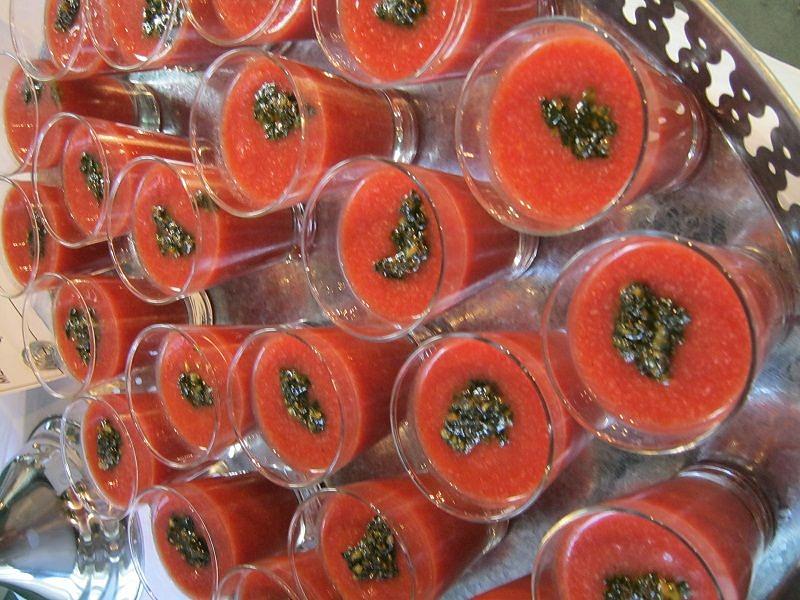Rachel's recipes: Tomato gazpacho

Gazpacho is a “liquid salad” of ingredients at their best and full of flavor. It's more important to use fresh bursting with flavor vegetables than follow an exact recipe. For example in Romania parsley root is abundant and this adds a wonderful celery note to the soup.
Many recipes use red peppers but I prefer to roast those and make a roasted pepper soup. I add raw onion – sweet white ones for depth of flavor and a strong dose of powerful antioxidants. I have served gazpacho with vodka shots as an elegant dinner party starter and I have drunk it out of a bottle when recovering from hangovers (likely caused by excessive dinner parties...)
The contentious gazpacho issue is the inclusion of bread. The classic Andalusian tomato and bread soup is of course “salmorejo”. The bread emulsifies the soup and personally I prefer it. Try both and see what you prefer or add a little bread just to emulsify.
One word of warning: cheap “cotton wool” processed bread contains chemicals that render the bread “slimey” when mixed with water and slightly “gluey”. It really is worth making with real bread.
Ingredients
Serves 4
100g slightly stale good crusty white bread, soaked in cold water for 20 minutes (optional)
1kg very ripe tomatoes, diced
1 ripe red pepper and 1 green pepper, deseeded and diced (optional really)
1 medium cucumber, peeled and diced
2 cloves of garlic
150ml extra virgin olive oil
Salt, to taste
Gadgets & Gizmos: a blender or liquidizer or stick blender. A strong sieve or food mill if you want the gazpacho without seeds and skin. (However the highest concentration of the carotenoids found in tomatoes is found in the skin so this is a good reason not to over process the soup and not to peel your tomatoes! I never bother unless making Salmorejo for a dinner party)
How To
Chop up your vegetables roughly.
Put all the ingredients in the blender and process until smooth.
If you want to, pass the mixture through a fine sieve or food mill.
If you want to make “salmorejo” then add the bread (squeeze out the water and add torn up chunks) and process until a deep salmon color and a smooth emulsified almost mayonaisy consistency.
Serve dribbled with olive oil, with pesto, with “leustean” leaves (lovage) or even crispy Serrano ham. The traditional garnish for Salmorejo is crispy ham and crumbled boiled egg.
Here are a few reminders why Gazpacho is a tonic indeed:
Onion may be a useful herb for the prevention of cardiovascular disease, especially since it diminishes the risk of blood clots. Onion also protects against stomach and other cancers, as well as protecting against certain infections. Onion can improve lung function, especially in asthmatics. The stronger the onion the greater the concentration of health-promoting phytochemicals.
Tomatoes contain all four major carotenoids: alpha- and beta-carotene, lutein, and lycopene. These carotenoids may have individual benefits, but also have synergy as a group (that is, they interact to provide health benefits). In particular, tomatoes contain exceptionally high amounts of lycopene, thought to have the highest antioxidant activity of all the carotenoids. One study showed that eating tomatoes and broccoli combined decreased the risk of prostate cancer. Tomatoes contain all three high-powered antioxidants: beta-carotene (which has vitamin A activity in the body), vitamin E, and vitamin C. Tomatoes are rich in potassium, a mineral most of us don't get enough of. When tomatoes are eaten along with healthier fats, like avocado or olive oil, the body's absorption of the carotenoid phytochemicals in tomatoes is reported to increase by two to 15 times, according to a study from Ohio State University.
Olive Oil If like me you can drink olive oil from a bottle, soak bread in it ad infinitum and find recipes and uses for it every day then comfort yourself with the following data!
The main type of fat found in all kinds of olive oil is monounsaturated fatty acids (MUFAs). MUFAs are actually considered a healthy dietary fat. If your diet emphasizes unsaturated fats, such as MUFAs and polyunsaturated fats (PUFAs), instead of saturated fats and the deadly “trans fats” present in so much processed food, you may gain certain health benefits.
By Rachel Sargent, guest writer
(photo source: Rachel Sargent)















